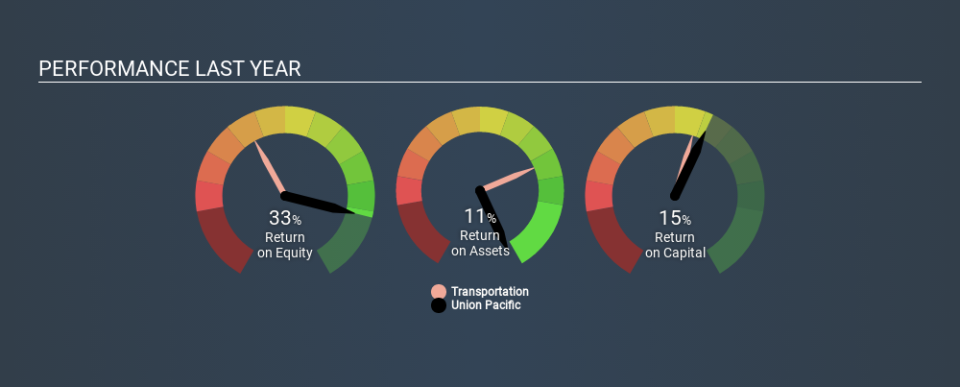Is Union Pacific Corporation’s (NYSE:UNP) 15% ROCE Any Good?

Today we'll look at Union Pacific Corporation (NYSE:UNP) and reflect on its potential as an investment. In particular, we'll consider its Return On Capital Employed (ROCE), as that can give us insight into how profitably the company is able to employ capital in its business.
Firstly, we'll go over how we calculate ROCE. Next, we'll compare it to others in its industry. Last but not least, we'll look at what impact its current liabilities have on its ROCE.
Understanding Return On Capital Employed (ROCE)
ROCE measures the amount of pre-tax profits a company can generate from the capital employed in its business. In general, businesses with a higher ROCE are usually better quality. Ultimately, it is a useful but imperfect metric. Renowned investment researcher Michael Mauboussin has suggested that a high ROCE can indicate that 'one dollar invested in the company generates value of more than one dollar'.
So, How Do We Calculate ROCE?
Analysts use this formula to calculate return on capital employed:
Return on Capital Employed = Earnings Before Interest and Tax (EBIT) ÷ (Total Assets - Current Liabilities)
Or for Union Pacific:
0.15 = US$8.6b ÷ (US$62b - US$4.4b) (Based on the trailing twelve months to December 2019.)
Therefore, Union Pacific has an ROCE of 15%.
View our latest analysis for Union Pacific
Does Union Pacific Have A Good ROCE?
ROCE can be useful when making comparisons, such as between similar companies. In our analysis, Union Pacific's ROCE is meaningfully higher than the 9.6% average in the Transportation industry. I think that's good to see, since it implies the company is better than other companies at making the most of its capital. Independently of how Union Pacific compares to its industry, its ROCE in absolute terms appears decent, and the company may be worthy of closer investigation.
The image below shows how Union Pacific's ROCE compares to its industry, and you can click it to see more detail on its past growth.
When considering ROCE, bear in mind that it reflects the past and does not necessarily predict the future. Companies in cyclical industries can be difficult to understand using ROCE, as returns typically look high during boom times, and low during busts. This is because ROCE only looks at one year, instead of considering returns across a whole cycle. Future performance is what matters, and you can see analyst predictions in our free report on analyst forecasts for the company.
What Are Current Liabilities, And How Do They Affect Union Pacific's ROCE?
Current liabilities include invoices, such as supplier payments, short-term debt, or a tax bill, that need to be paid within 12 months. The ROCE equation subtracts current liabilities from capital employed, so a company with a lot of current liabilities appears to have less capital employed, and a higher ROCE than otherwise. To counter this, investors can check if a company has high current liabilities relative to total assets.
Union Pacific has total assets of US$62b and current liabilities of US$4.4b. Therefore its current liabilities are equivalent to approximately 7.1% of its total assets. Low current liabilities have only a minimal impact on Union Pacific's ROCE, making its decent returns more credible.
What We Can Learn From Union Pacific's ROCE
This is good to see, and while better prospects may exist, Union Pacific seems worth researching further. There might be better investments than Union Pacific out there, but you will have to work hard to find them . These promising businesses with rapidly growing earnings might be right up your alley.
If you are like me, then you will not want to miss this free list of growing companies that insiders are buying.
If you spot an error that warrants correction, please contact the editor at editorial-team@simplywallst.com. This article by Simply Wall St is general in nature. It does not constitute a recommendation to buy or sell any stock, and does not take account of your objectives, or your financial situation. Simply Wall St has no position in the stocks mentioned.
We aim to bring you long-term focused research analysis driven by fundamental data. Note that our analysis may not factor in the latest price-sensitive company announcements or qualitative material. Thank you for reading.

 Yahoo Finance
Yahoo Finance 
